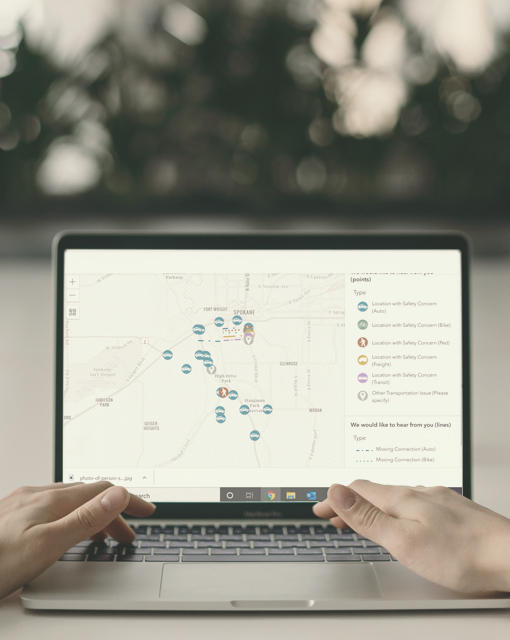Community Engagement During COVID-19
Partner with Us to Pivot Our Research
Our current era of social distancing has presented all of us with unique challenges related to community engagement. Although some projects may go on pause or re-shift focus to other technical evaluations while we are all encouraged to remain physically distant from one another, there are other projects that must keep advancing in order to address urgent mobility, access, and safety priorities. In many cases, receiving authentic feedback, ideas, and input from a community is vital to a project’s success, even while we are asked to remain physically distant. With this background in mind, we have been listening to some of the key questions being asked by our clients and partners across the country during the COVID-19 response. We are taking action to accelerate new practices and innovations in community engagement that were already in our 2020 Research & Development (R&D) agenda, and identifying the best new ways to effectively conduct community engagement not only in these difficult times, but also with an eye toward advancing our industry’s best practices into the future.
What We’re Hearing
- How do we infuse equity and access into the process when conducting engagement using online platforms? How do we ensure that we include vulnerable communities during our digital engagement?
- Is it better to postpone engagement until social distancing orders are lifted, given people’s current everyday concerns?
- How do we build or strengthen relationships with community partners with the understanding that we can build on these collaborations for even more effective engagement when social distancing restrictions ease?
- What innovations in visual communications are most effective in capturing feedback and input? Asking people to read extensively can be tiring during stressful times, limiting engagement.
- How do we measure success with online engagement, and what are the specific metrics to help us identify if we’re reaching the right demographics?
- How do we make people feel heard during this time? Can an agency use some of that information to understand how people were impacted? Does this time present an opportunity to share stories and uplift how this experience affects how people travel?
- How do we, and should we, engage some communities now and return to communities we didn’t connect with later?

How We’re Responding
We are accelerating a pair of actions that were already on our R&D action plan and adapting them to the current situation:
- A focused set of actions in our Engagement Guide pulls forward strategies on equity and accessibility for all populations, identifies an array of tools for taking engagement both online and offline, and explores ways to both support and partner with community-based organizations working in our project areas. To be responsive to the current situation, we are highlighting specific resources that will be most effective during social distancing restrictions. For example, we are identifying the strengths and weaknesses of a half-dozen online engagement tools and refreshing our staff and clients about tools of the past that are now even more relevant, such as phone banks and mailers.
- Identifying Metrics of Successful Engagement is especially relevant. Now that much of our communication is becoming digital, how do we measure success when engaging the public? Fehr & Peers is prioritizing work on identifying metrics for success in engagement, as well as QA/QC measures for accessibility and inclusion to assess if there are communities we will need to return to and engage with when social distancing restrictions ease.
In addition to the accelerated items above, we have other actions on our R&D agenda that we are targeting for later in the year:
- New 3D and interactive visualizations to help communities understand the scope and scale of some of our projects that we are seeking feedback on
- New data sources to better depict travel (by mode, by route, by time of day), so that we can more accurately describe the project setting and address community perceptions about travel
- Continued investment in our internal Crowdsource+ online engagement tool to make it faster and easier to set up and with additional customizations requested by clients
- The testing and sharing of our feedback with emerging digital engagement strategies and platforms. As the pandemic has spread, there have been new techniques and tools emerging on a nearly daily basis. We look forward to evaluating these emerging tools and providing guidance to our clients and partners on what is right for them.
What We’re Seeking
Tell us about the needs and challenges facing your community, and let’s work toward solutions. Our investments in innovation are most useful when they address shared difficulties and obstacles across a wide array of regions and communities. Partner with us now to influence the direction of our community engagement research and collaborate with us in the work. Contact our leaders in this topic Caro Vera, Jeremy Klop, or Chris Breiland today to discuss your challenges, needs, and ideas with us. Together, we can meet this unique moment with the resolve that is needed to emerge stronger.
How is the pandemic changing things and how can we further shift our R&D efforts in response?
Here’s what we’re hearing from clients and partners in the areas of:
Quick Links
© 2017 – 2024 Fehr & Peers. All rights reserved.

